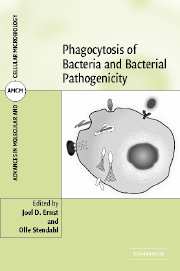Book contents
- Frontmatter
- Contents
- List of contributors
- 1 Introduction
- 2 Phagocytosis: receptors and biology
- 3 Receptor-initiated signal transduction during phagocytosis
- 4 Life, death, and inflammation: manipulation of phagocyte function by Helicobacter pylori
- 5 Phagocytosis of Streptococcus pneumoniae
- 6 Yersinia inhibition of phagocytosis
- 7 Listeria invasion and spread in non-professional phagocytes
- 8 Mycobacterium tuberculosis: mechanisms of phagocytosis and intracellular survival
- Index
- Plate section
- References
8 - Mycobacterium tuberculosis: mechanisms of phagocytosis and intracellular survival
Published online by Cambridge University Press: 07 August 2009
- Frontmatter
- Contents
- List of contributors
- 1 Introduction
- 2 Phagocytosis: receptors and biology
- 3 Receptor-initiated signal transduction during phagocytosis
- 4 Life, death, and inflammation: manipulation of phagocyte function by Helicobacter pylori
- 5 Phagocytosis of Streptococcus pneumoniae
- 6 Yersinia inhibition of phagocytosis
- 7 Listeria invasion and spread in non-professional phagocytes
- 8 Mycobacterium tuberculosis: mechanisms of phagocytosis and intracellular survival
- Index
- Plate section
- References
Summary
INTRODUCTION
Mycobacterium tuberculosis, the cause of tuberculosis, has infected an estimated one-third of the world's human population and causes more deaths per year than any other single bacterial pathogen (Corbett et al. 2003). Although tuberculosis is most frequently an infection of the lungs, it can affect virtually any organ of the body (Raviglione & O'Brien 2004). In most individuals the infection remains latent without symptoms or transmission, but in approximately 10% the infection progresses to active disease and kills at least half of these. Untreated, active disease provides the opportunity for transmission of M. tuberculosis to other individuals through coughing up of the bacteria by an infected person, which provides droplet nuclei that are inhaled into the lung alveoli and establish a new infection. Tuberculosis is most common in developing countries; because T-lymphocyte-mediated cellular immunity is essential for control of the infection, the ongoing epidemic of HIV infection in regions with a high prevalence of tuberculosis is worsening an already severe problem. Moreover, the development of multiple drug resistance in M. tuberculosis has amplified the problems of treatment of tuberculosis in many parts of the world.
LIFE CYCLE OF M. TUBERCULOSIS
Although bacteria are not classically considered to have morphologically distinct stages representing phases of their life cycle as eucaryotic parasites do, it is clear that pathogenic bacteria such as M. tuberculosis adapt to distinct environmental niches by major alterations in their patterns of gene expression (Schnappinger et al. 2003).
- Type
- Chapter
- Information
- Phagocytosis of Bacteria and Bacterial Pathogenicity , pp. 246 - 272Publisher: Cambridge University PressPrint publication year: 2006



